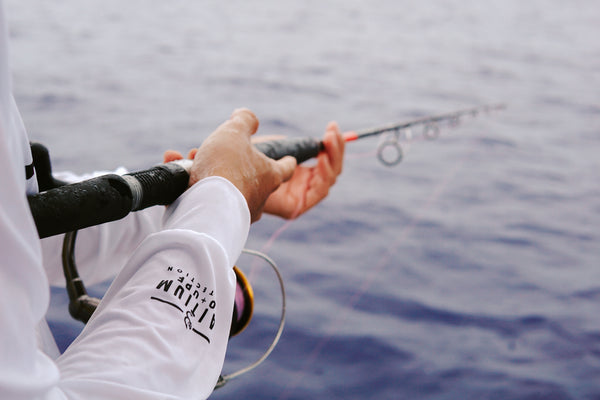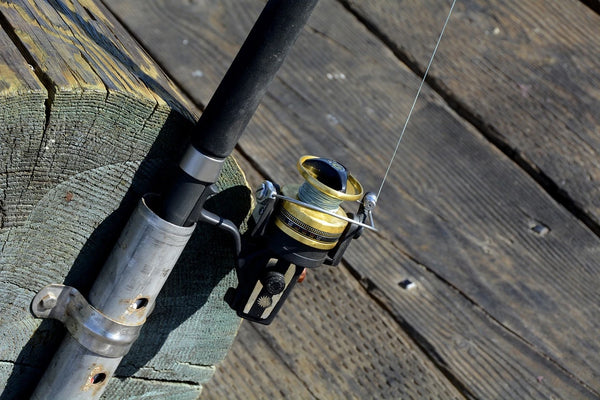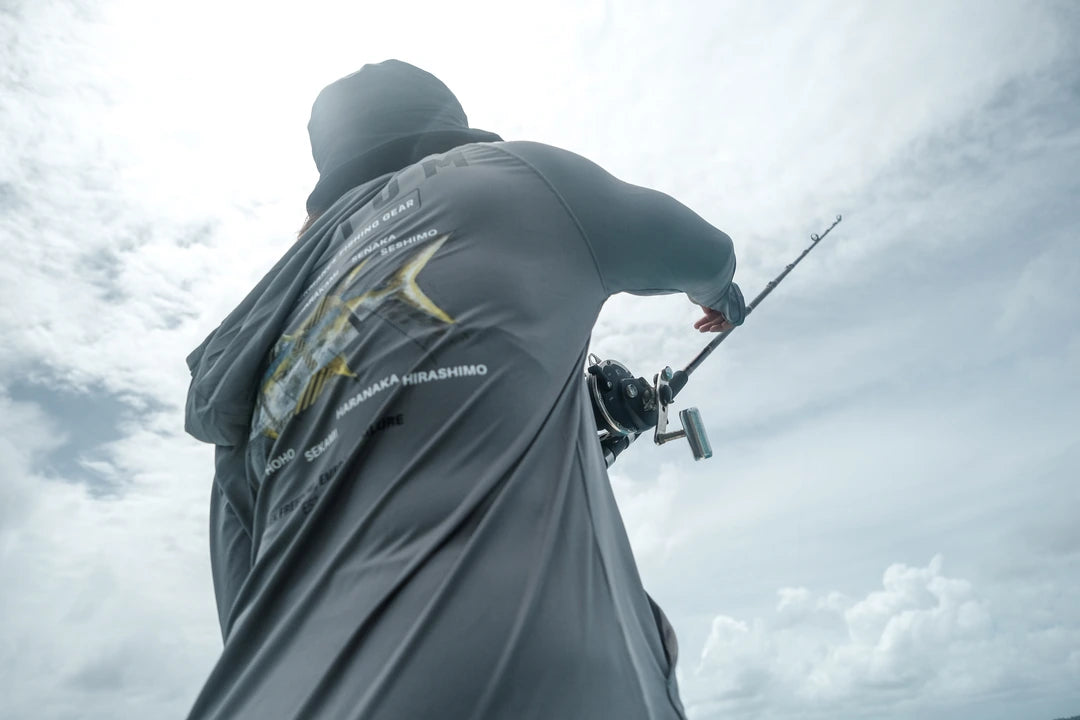Key takeaways
- Casting into the wind can mess up your fishing game. Make sure to adapt your technique to the wind's direction to avoid tangling your line.
- Overfilling the spool is a recipe for tangles. Check your reel manufacturer's guidelines for the maximum amount of line and stick to it.
- Proper storage goes a long way. Keep your fishing line in a cool and shaded spot, and check for wear and tear often to minimize the risk of tangles.
Getting your fishing line tangled is like a rite of passage that none of us signed up for. We've all been there, casting our lines with hope and confidence, only to end up with a knotted mess (also known as backlash, bird’s nest, or professional overrun to anglers) instead of the monster catch we were aiming for.
A tangled fishing line makes it difficult to cast and can even damage the line. It might lead you to lose fish, find it hard to feel when they're biting, and make you waste your precious time out on the water.
It’s, without a doubt, one of the most frustrating things that can happen while fishing. The worst part is that it can happen to you whether you're a fresh-faced beginner trying to impress, or a seasoned pro taking on the challenges of both saltwater and freshwater fishing. (If you listen hard enough, you can probably hear the fish laughing as you fumble with your reel.)
And untangling the line? Now that's a test of patience that can make even the calmest angler consider taking up a less complicated hobby.

The good news is that tangled fishing lines don’t have to ruin your day by the water. Understanding why they happen, how to prevent them, and what to do if your line gets tangled, are all part of learning how to fish. By casting properly, filling our reel with just the right amount of line, taking care of our gear, paying attention to line memory, and adding in a dash of patience, we can certainly reduce the chances of tangling.
So let’s leave those tangled days behind, or at least make them a rare event worthy of a chuckle or two!
Table of Contents
Why does my fishing line keep getting tangled?
There are several reasons why your fishing line may keep getting tangled. Here are a few of them:
- Casting into the wind
- Excess line on reel
- Improper spooling and fishing line storage
- Fishing line memory issues
- Too much slack in the line
Addressing these causes can help you significantly decrease the likelihood of those pesky tangles.

Casting into the wind
Casting into the wind is one of the biggest causes of tangled fishing lines. To prevent tangles, sometimes called wind knots when they’re caused by casting into the wing, you need to understand the direction of the wind and its effect on your fishing. If you cast directly into strong winds, the wind can blow the line and lure back towards you, and this can create a mess on the spool.
To overcome this challenge, positioning is key. By positioning yourself with the wind at your back whenever possible, you can minimize the wind's interference with the line. This alignment helps maintain control and prevent those frustrating loops and tangles.
If casting with the wind at your back is not an option, another technique is to cast low to the surface of the water. This minimizes the wind's impact on the line and allows for more accurate casting.
Adapting your casting technique to the wind's direction can significantly reduce the chances of line tangling.
Too much fishing line
Another common mistake that increases the chances of tangled lines is an overfilled spool. When the spool is overfilled, the line may not unwind evenly as it is cast, leading to tangles.
Finding the right amount of line to use on a fishing spool might seem like a guessing game, but it actually just depends on the type of reel and the maximum amount of line your spool can handle, which your reel manufacturer provides.

Now, if you're like me and appreciate a good tool to make life easier, you'll be happy to know that there are fishing reel line capacity calculators out there. These handy calculators require you to enter the line diameter and length, and they will estimate how much line you can put on your spool.
While filling up the spool, it's also a good idea to leave a small gap of about an eighth of an inch between your line and the edge of the spool to help keep your line manageable and keep those tangles at bay.
Incorrect spooling
Mistakes in spooling also frequently cause tangles. Your best bet is to follow the manufacturer’s recommendations on how to correctly spool your reel. Make sure your reel is clear of any gunk. Take it slow and easy, no need to rush. Use your fingers to keep a bit of tension on the line as you wind it onto the reel to minimize tangles.
Need a UPF shirt for your next outdoor adventure? Check out our recommendations!
Problems with fishing line memory
Let’s talk about fishing line memory - it’s how line can “remember” the shape of the spool it's been wound on, making it all curly and coiled when you unravel it. This tends to happen if the line sits on the spool for a while. The longer it hangs out like that, the more it gets all coiled up. Those coils can end up getting caught on things like guides or other parts of your fishing gear, leading to tangles and knots.
No worries, though, there are a few tricks to keep that memory in check. For starters, be picky about your line choice. Look for lines that are labeled as having minimal or low memory. Braided lines are known to hardly hold on to memory, so, they're a solid bet. On the other hand, monofilament lines are notorious for developing memory and coiling up. We talk more about the different kinds of fishing line, their pros and cons, and which ones to choose depending on your fishing situation in a previous post.
Improper fishing line storage
When it comes to fishing gear storage, leaving your line exposed to direct sunlight or stored in areas where the temperature gets too high, can also lead to line memory problems.
When you’re not fishing, keep your line in a cool and shady place. You can also give your line some gentle stretch to straighten out those coils and steer clear of tangling. Check the fishing line often to see if it's worn out or damaged, because if it is, it can get tangled more easily. Check out our post on Fishing Gear Storage and Maintenance for a more thorough guide on this.
Slack line
When there's too much slack in the line, it can get tangled while casting or pulling it in. This is a common problem for those who fish in the ocean, as they often face strong winds and fast-moving water. To stop your line from getting loose, maintain tension on it while reeling in. You can do this by holding the line with your fingers to keep it tight or by changing the settings on your reel.
Summary
Here's a summary of the do's and don'ts to prevent fishing line tangles.

Final thoughts
When it comes to fishing, dealing with tangled lines can be super frustrating. What's worse is that they can mess up your chances of catching fish, damage your gear, and waste a ton of time. Being patient and building a deeper understanding of what causes fishing line tangles is important. By learning what causes these tangles, you're taking a step forward to make sure your fishing trips go more smoothly, and you get to enjoy those beautiful catches.
Lastly, don't keep these tips to yourself! Share them with your fishing buddies and other people who love to fish, so everyone can enjoy the sport without getting all tangled up in frustration.
MOST READ NEWS:
What is the Best Bait for Catfish?
Heading out to catch catfish? Choosing the appropriate bait is important for your fishing mission. Catfish rely on their keen sense of smell and taste to locate food. Selecting the right bait can effectively attract catfish and increase your chances of landing a catch.
Learn to Reel in Fish Like a Pro: A Beginner's Guide to Landing the Catch
Reeling in a fish properly is one of the most important basics that every angler, especially beginners, needs to know. Even if you've been fishing for a while, it's always good to review these fundamental techniques. If you don't reel in correctly, you risk losing the fish or even breaking your line.
Can Fish Smell Underwater?
Have you ever wondered if fish can smell underwater? It's a question that many of us anglers ponder, as the answer could have significant implications for our fishing techniques and choice of bait or lure. Some people might assume that fish can't smell underwater because humans can't smell while submerged. After all, we breathe air, not water, so it's hard for us to imagine detecting scents in an aquatic environment. However, this assumption is far from the truth. Fish have a remarkable sense of smell that plays a crucial role in their survival, and understanding how they use this sense can help anglers become more successful on the water.
How To Fish Jerkbaits: Pro Tips
Jerkbaits, popular among anglers since the 1930s, are versatile lures that mimic the erratic, off-center wobble of injured baitfish. Designed by Finnish angler Lauri Rapala, these lures feature a thin, elongated body with two treble hooks and a front lip, available in floating, suspending, and deep diving options.
Catch More Fish with Drop Shot, Carolina, and Ned Rigs
One thing remains constant whether you're a seasoned pro or a passionate weekend warrior: the key to consistently catching fish lies in your ability to adapt to different situations and present your bait in the most enticing way possible. This is where the importance of using the right fishing rigs comes into play. But with so many options out there, it can be overwhelming to know where to start.
Crappie Jig Hacks: Boost Your Catch Rate with These Simple Tricks
Crappie jigs are a popular and effective lure choice for anglers targeting crappie. These compact lures consist of a weighted head and a hook, typically adorned with a soft plastic or other material body designed to mimic the appearance of small baitfish like minnows or shad.
Top 10 Fishing Essentials for a Successful 2024 Season
Attention all fishing enthusiasts! As we eagerly anticipate the start of the 2024 fishing season, it's time to ensure you have all the necessary gear and accessories to make your time on the water truly unforgettable. In this article, we'll explore the top 10 fishing essentials that can significantly enhance your fishing experience, with a special focus on eco-friendly and innovative products that are sure to impress. They also make great fishing gifts for friends and family, or even a well-deserved treat for yourself (because why not?).
Must-Master Fishing Techniques for the 2024 Fishing Season
As the weather warms up and the 2024 fishing season kicks into high gear, it's the perfect time for anglers to refine their skills and master essential techniques that will lead to success on the water. Whether you're a seasoned pro or a newcomer to the world of fishing, focusing on these key techniques will help you make the most of your time on the water and create unforgettable memories.
The Ultimate Spring Fishing Checklist
With the sun shining and the weather warming up, it's the perfect time to enjoy the great outdoors and take advantage of some excellent fishing opportunities. Check your gear, tackle box, and boat (if applicable) to ensure everything is in good condition and ready for use. Verify that your fishing license is current and you have all necessary permits. Regulations vary by state and can change annually, so stay informed to avoid fines or legal consequences.

